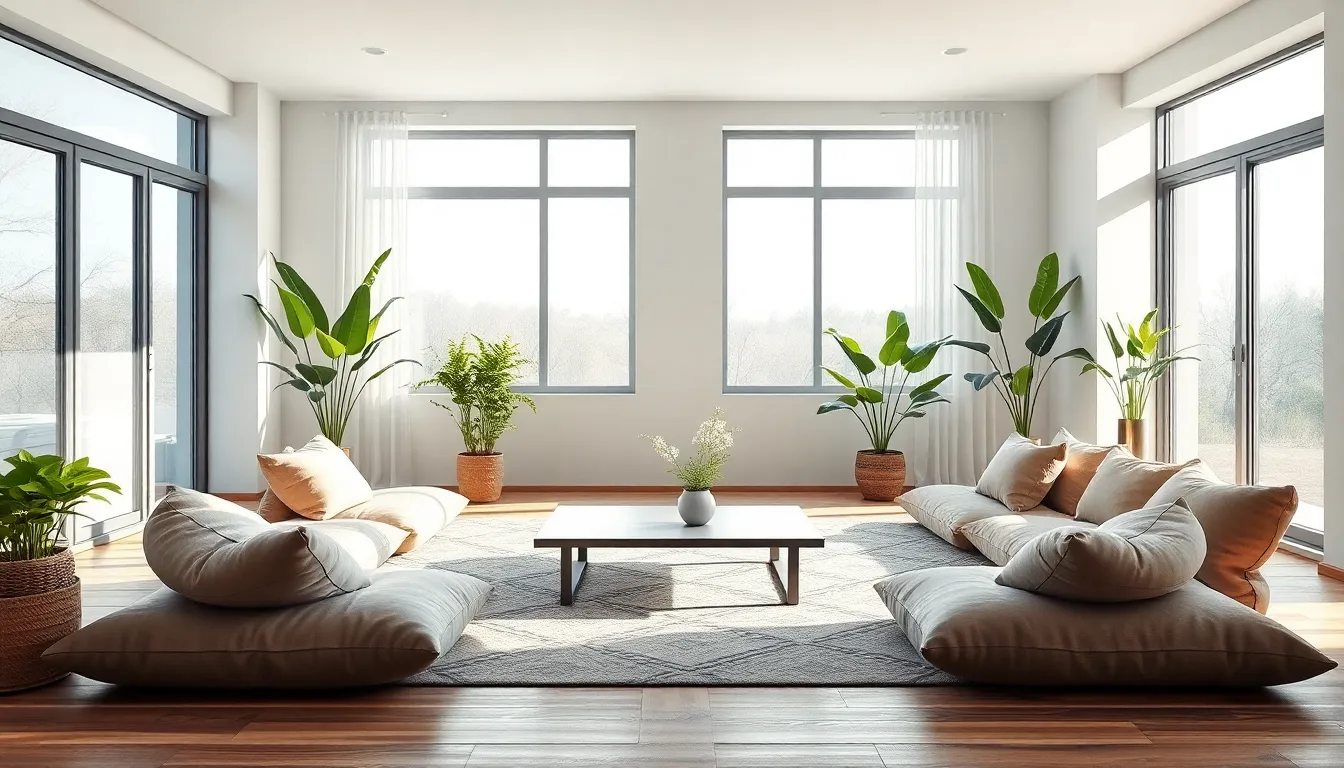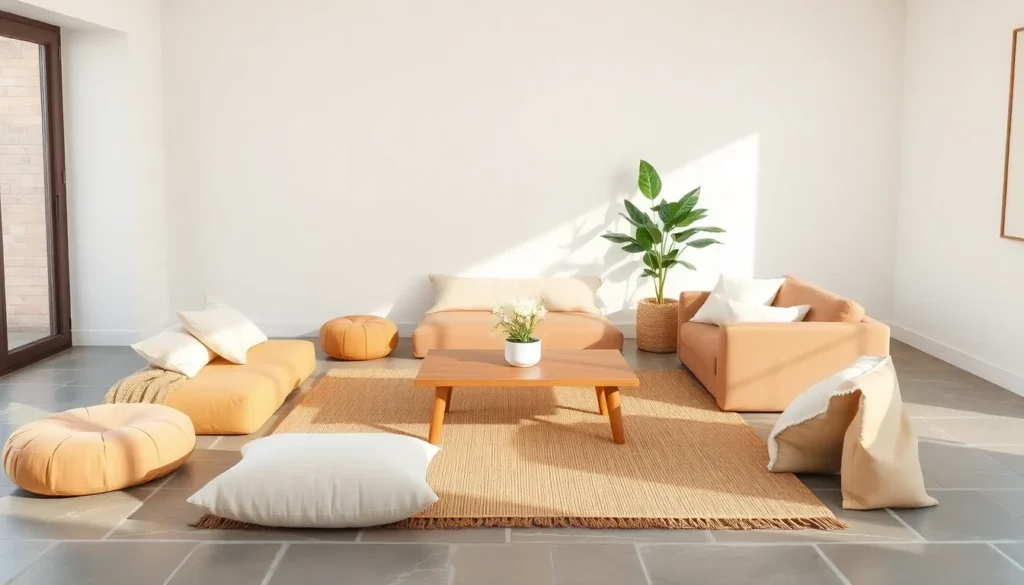Table of Contents
ToggleImagine walking into a living room that feels like a breath of fresh air. No bulky sofa hogging all the space just a serene oasis where simplicity reigns supreme. Minimalist living rooms without sofas are taking the design world by storm, proving that comfort doesn’t have to come in the form of oversized furniture.
Instead of sinking into cushions the size of small islands, think about creating a space that sparks joy and creativity. With clever seating alternatives and smart layout choices, it’s possible to achieve both style and functionality. Plus who needs a sofa when you can have a chic floor cushion that doubles as a dance partner during impromptu living room parties? Dive into the world of minimalist design and discover how to transform your space into a stylish sanctuary that’s ready for both relaxation and entertaining.
What Is Minimalist Living Room Without Sofa?
A minimalist living room without a sofa focuses on simplicity and functionality. This design trend eliminates bulky furniture, creating open space for flexibility and creativity. Floor cushions, poufs, or low seating options serve as comfortable alternatives. These options maintain a chic aesthetic while allowing for easy arrangement and movement.
The layout emphasizes clean lines and uncluttered surfaces, encouraging a more serene environment. Incorporation of multi-functional furniture plays a significant role in enhancing usability. For example, a coffee table can double as a storage unit, reducing visible clutter.
Natural materials like wood, stone, and textiles contribute to a warm atmosphere while staying true to minimalist principles. Soft textures and muted colors help create a calming effect in the living space. To enhance comfort and functionality, strategically placed rugs define seating areas and add visual interest.
Furthermore, art and decor can express personality without overwhelming the space. A few carefully chosen pieces can become focal points that draw attention, while maintaining the overall simplicity. Plants also add life and freshness, blending seamlessly into the minimalist aesthetic.
Ultimately, a minimalist living room without a sofa embodies versatility and innovation. This approach promotes relaxation and social interaction in a style-conscious setting. Embracing such designs invites individuals to rethink traditional living room concepts while achieving comfort and elegance.
Benefits of Minimalist Living Room Without Sofa

Opting for a minimalist living room without a sofa offers various advantages that enhance both functionality and design. This approach emphasizes simplicity, creating open spaces that invite creativity.
Space Efficiency
Maximizing available space significantly increases with the absence of a bulky sofa. Floor cushions and poufs provide flexible seating, allowing for easy reconfiguration based on needs. Natural light flows unrestricted, contributing to an airy ambiance. The layout encourages movement, making the room feel more spacious. Multi-functional furniture, such as coffee tables that serve as storage, keeps areas tidy. These elements help define seating arrangements without overwhelming the room’s footprint. Space efficiency fosters a relaxed environment, ideal for both daily living and entertaining guests.
Aesthetic Appeal
A minimalist living room without a sofa creates a chic, modern look that suits various design tastes. Clean lines and uncluttered surfaces establish a serene atmosphere. Natural materials, such as wood and textiles, enhance warmth and comfort alongside soft textures. Using muted colors maintains a calming effect, while carefully selected art pieces infuse personal style. Plants add freshness and vibrancy, making the space feel lively without being chaotic. This aesthetic promotes sophistication, yielding an inviting setting that balances elegance and comfort, while allowing individual expression.
Key Elements of Minimalist Living Room Without Sofa
A minimalist living room without a sofa prioritizes simplicity and versatile design. This approach to interior design emphasizes key elements that enhance both style and functionality.
Alternative Seating Options
Floor cushions provide an inviting and casual seating alternative. Poufs add an extra layer of comfort and can easily be moved or arranged as needed. Low benches serve as stylish seats while also offering surface area for drinks or decor. In addition, bean bags create a relaxed vibe, perfect for lounging. Seating options like stools can serve dual purposes as flexible seating or side tables. Each alternative contributes to an airy atmosphere while maintaining a chic aesthetic.
Functional Decor
Functional decor pieces blend beauty with practicality. Multi-functional coffee tables can act as both a central gathering point and additional storage. Shelves display art and keep books organized, maintaining a clean appearance. Wall hooks provide a stylish way to hang items without taking up floor space. Decorative baskets serve to hold items neatly while adding texture to the environment. Incorporating plants adds natural beauty while improving air quality, ensuring the space remains inviting and lively. Each decor choice reinforces the minimalist philosophy, perfectly complementing a sofa-free design.
Tips for Designing a Minimalist Living Room Without Sofa
Creating a minimalist living room without a sofa focuses on simplicity and functionality. Thoughtful design choices enhance the overall atmosphere.
Choosing the Right Colors
Selecting the right colors creates a soothing environment. Muted tones like soft grays, whites, and beiges foster a calming effect. Incorporating earth tones adds warmth and natural appeal. Accent colors can be used sparingly to highlight specific decor items. Maintaining a cohesive palette enhances the sense of spaciousness. Limiting color selections reduces visual clutter, further emphasizing the minimalist aesthetic. It’s essential to consider how light interacts with chosen colors to create a bright, inviting atmosphere. Opt for paint finishes that reflect light, enhancing the open feel of the room.
Incorporating Multi-Functional Furniture
Utilizing multi-functional furniture maximizes space and enhances usability. Choose coffee tables that offer storage options, promoting organization. Side tables can double as extra seating when needed. Consider low benches with hidden compartments to store items neatly. Poufs serve as both footrests and additional seating, making them versatile choices. Selecting decorative baskets helps maintain an uncluttered surface while adding style. Each piece should serve a clear purpose, ensuring that individual items contribute to the overall design. Design with flexibility in mind for easy reconfiguration, accommodating various activities in the living room.
Embracing a minimalist living room without a sofa opens up a world of design possibilities. It encourages creativity and flexibility in arranging spaces while maintaining comfort and style. The use of alternative seating options and multi-functional furniture not only enhances functionality but also promotes an airy ambiance.
By carefully selecting colors and materials, it’s possible to create a serene environment that reflects personal taste. This approach not only maximizes space but also fosters a welcoming atmosphere for both relaxation and social gatherings. A minimalist living room without a sofa truly redefines traditional concepts, inviting individuals to enjoy a chic and innovative living space.








